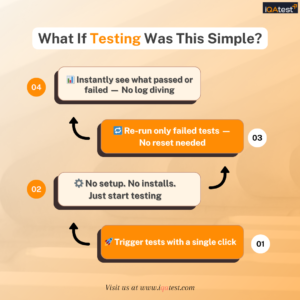Time is critical in a startup that evolves swiftly. Teams are very small and everybody plays several roles in their work. However, one unsaid reality that frequently affects quality is that not everyone in the team is proficient in using the automated test suite.
Despite being an automated process, test execution still becomes complex due to setup procedures, environment configurations, faulty test reports, and CI errors. Automation makes things more difficult rather than making it easier.
But what if testing does not require technical skills?
What if anyone on the team could trigger the automated tests easily in a single click without the need of any installations, or setting up anything?
It’s high time to rethink how test automation should actually be.
The Hidden Bottleneck in Modern Startups
Startups are fast-paced. Hence, new features arrive rapidly and releases may take place weekly (or even daily).
Then what happens to the automation test suite developed? It does end up being unused.
But why? The most often reasons for the ignorance of the test suites are:
- The developers will write the Playwright or Cypress tests, but they are rarely used.
- Although the setup of the test infrastructure is done, the QA person is the only one who really understands on how it operates.
- Nobody uses the test suite until something breaks or goes wrong.
That’s because running the automated tests still requires too much effort as manual tests.
Key Problems Faced by Teams
Triggering tests shouldn’t require technological knowledge. It shouldn’t be necessary to deal with CI logs in order to figure out what went wrong. You shouldn’t let deadlines pass as you wait for someone else to “run the suite.” The major problems faced are:
- To execute tests, you must switch between environments.
- When tests are inconsistent, people begin to doubt the test suite and disregard the failures.
- If the test results are not clear, manual verification of the reports is required.
- Designers, PMs, and other non-engineers never attempt to perform tests as they don’t have the required technical skills.
And the result?
The test suite that spent weeks developing with all your efforts ends up sitting idle and be used only when it is absolutely necessary. That’s not how automation should be.
Automated execution does not require technical skills
Unused test suites are not only a technical issue. Adapting the test suites fails even due to the assumption that automation is only meant for technical experts.
Imagine a system, where everyone (not just developers or QA) could:
- Run a test simply by just clicking a button.
- Get clear and understandable results immediately.
- Avoid any setup or installation efforts.
- Understand exactly what passed or failed without looking through logs.
You’re doing more than just automated tests now. You’re making it possible for everyone on the team to contribute to quality.
What If Testing Was This Simple?
Let’s explore what test automation in a startup could look like:
- A PM completes a feature review. They execute the test suite with a single click prior to signing off.
- A designer makes adjustments to user interface components and reruns visual regression tests, without seeking any QA assistance.
- There is no more “digging through logs” and the person running the tests will receive simple and clear test reports.
- The test suite is trusted by the entire team due to its frequent execution and user-friendliness.
A proper way to automate tests is by making test execution a part of everyone’s workflow rather than just developing tests.
The Benefits of Regularizing Test Execution
Enabling testing for everyone does more than just reduce complexity. It gives a lot more benefits:
- There is no need to wait on QA assistance in execution.
- Non-tech team members, designers, and project managers can participate in the quality discussion.
- Tests are actually run before the bugs reach production, which results in fewer defects at release.
- All members are aware of what is and is not functioning.
This is not just a Dream. It’s the right way to automate tests.
Because test automation should be:
- Easy
- Accessible
- Effortless
Quality is a Team Sport
Every minute counts in developing startups. The future goal of testing is to make the execution simple and accessible for everyone, instead of just those who write test scripts. Test automation should be a benefit rather than adding to your workload. Because when testing is this simple, teams will start to rely on it rather than avoiding it. And that’s how you can confidently deliver your products more quickly.
